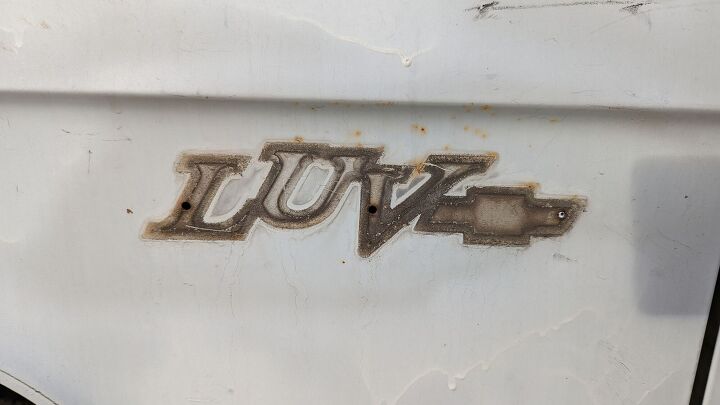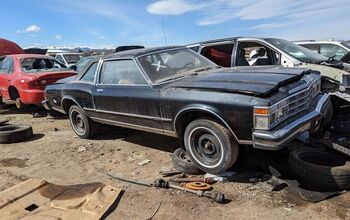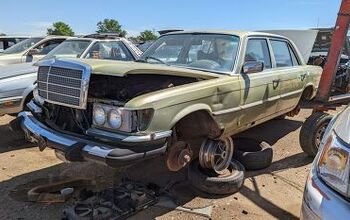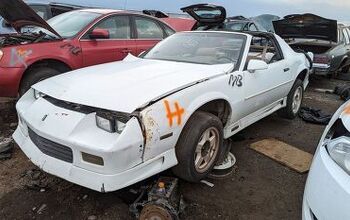Junkyard Find: 1978 Chevrolet LUV

Small Japanese pickups became increasingly popular in North America as the 1970s went on, with plenty of Hiluxes and 520s/ 620s rolling out of Toyota and Datsun showrooms. Detroit wanted some of that minitruck money, and so each of the Big Three turned to a Japanese partner to make it happen. Today's Junkyard Find is the GM player in that game, found in a self-service boneyard near Reno, Nevada.
The Chevy LUV (which stands for Light Utility Vehicle) was really an Isuzu Faster, built in Kanagawa Prefecture. The first LUVs arrived on our shores in 1972.
Ford began importing Mazda Proceeds with Courier badges at around the same time. Eventually, North Americans could also buy these trucks with Mazda badges (and even with Wankel engines).
Chrysler was a little slower to join in, importing Mitsubishi Forte pickups with Plymouth Arrow and Dodge D-50/ Ram 50 badging starting in 1979. Ram 50s could be bought new here all the way through 1994, more than a decade after Mitsubishi began selling the same trucks with Mighty Max badging.
This truck has a battered camper shell that seems to be nearly as old as it is.
Made by Parker Industries in Arizona.
A junkyard shopper bought the engine, which would have been a 1.8-liter SOHC straight-four rated at 80 horsepower. The Chevrolet Chevette got smaller-displacement versions of this engine (or a 1.8-liter Isuzu diesel).
Starting in 1979, LUV shoppers could get four-wheel-drive. This one is a rear-wheel-drive truck with a good old four-on-the-floor manual. A three-speed automatic was available.
The LUV's days were numbered from the moment GM began planning the Chevrolet S-10. The S-10 first hit showrooms as a 1982 model, and that ended up being the LUV's final year of sales.
Isuzu was selling its vehicles in North America under its own name by that time, so new Fasters remained available here (first as the P'up and later as just the Isuzu Truck).
It appears that someone tried to sell this LUV for a hundred dollars, but found no takers. It's thoroughly battered but not rusty.
How many packs of Pyramids was it worth at the end?
When equipped with the optional automatic transmission, you can tow a 172-ton freight train loaded with LUVs.
GM really pushed that automatic. I've found exactly one junkyard LUV with two pedals.
[Images: The author]
Become a TTAC insider. Get the latest news, features, TTAC takes, and everything else that gets to the truth about cars first by subscribing to our newsletter.

Murilee Martin is the pen name of Phil Greden, a writer who has lived in Minnesota, California, Georgia and (now) Colorado. He has toiled at copywriting, technical writing, junkmail writing, fiction writing and now automotive writing. He has owned many terrible vehicles and some good ones. He spends a great deal of time in self-service junkyards. These days, he writes for publications including Autoweek, Autoblog, Hagerty, The Truth About Cars and Capital One.
More by Murilee Martin
Latest Car Reviews
Read moreLatest Product Reviews
Read moreRecent Comments
- FreedMike Not surprisingly, I have some ideas. What Cadillac needs, I think, is a statement. They don’t really have an identity. They’re trying a statement car with the Celestiq, and while that’s the right idea, it has the wrong styling and a really wrong price tag. So, here’s a first step: instead of a sedan, do a huge, fast, capable and ridiculously smooth and quiet electric touring coupe. If you want an example of what I’m thinking of, check out the magnificent Rolls-Royce Spectre. But this Cadillac coupe would be uniquely American, it’d be named “Eldorado,” and it’d be a lot cheaper than the $450,000 Spectre – call it a buck twenty-five, with a range of bespoke options for prospective buyers that would make each one somewhat unique. Make it 220 inches long, on the same platform as the Celestiq, give it retro ‘60s styling (or you could do a ‘50s or ‘70s throwback, I suppose), and at least 700 horsepower, standard. Why electric? It’s the ultimate throwback to ‘60s powertrains: effortlessly fast, smooth, and quiet, but with a ton more horsepower. It’s the perfect drivetrain for a dignified touring coupe. In fact, I’d skip any mention of environmental responsibility in this car’s marketing – sell it on how it drives, period. How many would they sell? Not many. But the point of the exercise is to do something that will turn heads and show people what this brand can do. Second step: give the lineup a mix of electric and gas models, and make Cadillac gas engines bespoke to the brand. If they need to use generic GM engine designs, fine – take those engines and massage them thoroughly into something special to Cadillac, with specific tuning and output. No Cadillac should leave the factory with an engine straight out of a Malibu or a four-banger Silverado. Third step: a complete line-wide interior redo. Stop the cheapness that’s all over the current sedans and crossovers. Just stop it. Use the Lyriq as a blueprint – it’s a big improvement over the current crop and a good first step. I’d also say Cadillac has a good blend of screen-controlled and switch-controlled user interfaces; don’t give into the haptic-touch and wall-to-wall screen thing. (On the subject of Caddy interiors – as much as I bag on the Celestiq, check out the interior on that thing. Wow.)Fourth step: Blackwing All The Things – some gas, others electric. And keep the electric/gas mix so buyers have a choice.Fifth step: be patient. That’s not easy, but if they’re doing a brand reset, it’ll take time.
- NJRide So if GM was serious about selling this why no updates for so long? Or make something truly unique instead of something that looked like a downmarket Altima?
- Kmars2009 I rented one last fall while visiting Ohio. Not a bad car...but not a great car either. I think it needs a new version. But CUVs are King... unfortunately!
- Ajla Remember when Cadillac introduced an entirely new V8 and proceeded to install it in only 800 cars before cancelling everything?
- Bouzouki Cadillac (aka GM!!) made so many mistakes over the past 40 years, right up to today, one could make a MBA course of it. Others have alluded to them, there is not enough room for me to recite them in a flowing, cohesive manner.Cadillac today is literally a tarted-up Chevrolet. They are nice cars, and the "aura" of the Cadillac name still works on several (mostly female) consumers who are not car enthusiasts.The CT4 and CT5 offer superlative ride and handling, and even performance--but, it is wrapped in sheet metal that (at least I think) looks awful, with (still) sub-par interiors. They are niche cars. They are the last gasp of the Alpha platform--which I have been told by people close to it, was meant to be a Pontiac "BMW 3-series". The bankruptcy killed Pontiac, but the Alpha had been mostly engineered, so it was "Cadillac-ized" with the new "edgy" CTS styling.Most Cadillacs sold are crossovers. The most profitable "Cadillac" is the Escalade (note that GM never jack up the name on THAT!).The question posed here is rather irrelevant. NO ONE has "a blank check", because GM (any company or corporation) does not have bottomless resources.Better styling, and superlative "performance" (by that, I mean being among the best in noise, harshness, handling, performance, reliablity, quality) would cost a lot of money.Post-bankruptcy GM actually tried. No one here mentioned GM's effort to do just that: the "Omega" platform, aka CT6.The (horribly misnamed) CT6 was actually a credible Mercedes/Lexus competitor. I'm sure it cost GM a fortune to develop (the platform was unique, not shared with any other car. The top-of-the-line ORIGINAL Blackwing V8 was also unique, expensive, and ultimately...very few were sold. All of this is a LOT of money).I used to know the sales numbers, and my sense was the CT6 sold about HALF the units GM projected. More importantly, it sold about half to two thirds the volume of the S-Class (which cost a lot more in 201x)Many of your fixed cost are predicated on volume. One way to improve your business case (if the right people want to get the Green Light) is to inflate your projected volumes. This lowers the unit cost for seats, mufflers, control arms, etc, and makes the vehicle more profitable--on paper.Suppliers tool up to make the number of parts the carmaker projects. However, if the volume is less than expected, the automaker has to make up the difference.So, unfortunately, not only was the CT6 an expensive car to build, but Cadillac's weak "brand equity" limited how much GM could charge (and these were still pricey cars in 2016-18, a "base" car was ).Other than the name, the "Omega" could have marked the starting point for Cadillac to once again be the standard of the world. Other than the awful name (Fleetwood, Elegante, Paramount, even ParAMOUR would be better), and offering the basest car with a FOUR cylinder turbo on the base car (incredibly moronic!), it was very good car and a CREDIBLE Mercedes S-Class/Lexus LS400 alternative. While I cannot know if the novel aluminum body was worth the cost (very expensive and complex to build), the bragging rights were legit--a LARGE car that was lighter, but had good body rigidity. No surprise, the interior was not the best, but the gap with the big boys was as close as GM has done in the luxury sphere.Mary Barra decided that profits today and tomorrow were more important than gambling on profits in 2025 and later. Having sunk a TON of money, and even done a mid-cycle enhancement, complete with the new Blackwing engine (which copied BMW with the twin turbos nestled in the "V"!), in fall 2018 GM announced it was discontinuing the car, and closing the assembly plant it was built in. (And so you know, building different platforms on the same line is very challenging and considerably less efficient in terms of capital and labor costs than the same platform, or better yet, the same model).So now, GM is anticipating that, as the car market "goes electric" (if you can call it that--more like the Federal Government and EU and even China PUSHING electric cars), they can make electric Cadillacs that are "prestige". The Cadillac Celestique is the opening salvo--$340,000. We will see how it works out.












































Comments
Join the conversation
Spookiness--Many more people would own a Maverick as well. Ford underestimated the demand for a compact pickup and by the time Ford gets production of the Maverick up to where most people can buy and test drive them without paying above MSRP or ordering one other manufacturers will have entered the market with their own compact pickup. Toyota has plans to introduce a hybrid compact pickup using the Rav4 platform and even Ram has plans for a compact pickup in the next year. Even though Maverick is outselling the Santa Cruz people who have waited for a Maverick are buying the Santa Cruz. Both the Santa Cruz and the Maverick are good and the more manufacturers that make their own compact pickup is better for all. More choice is always better.
A restomod project for those who think all pickups are too big.